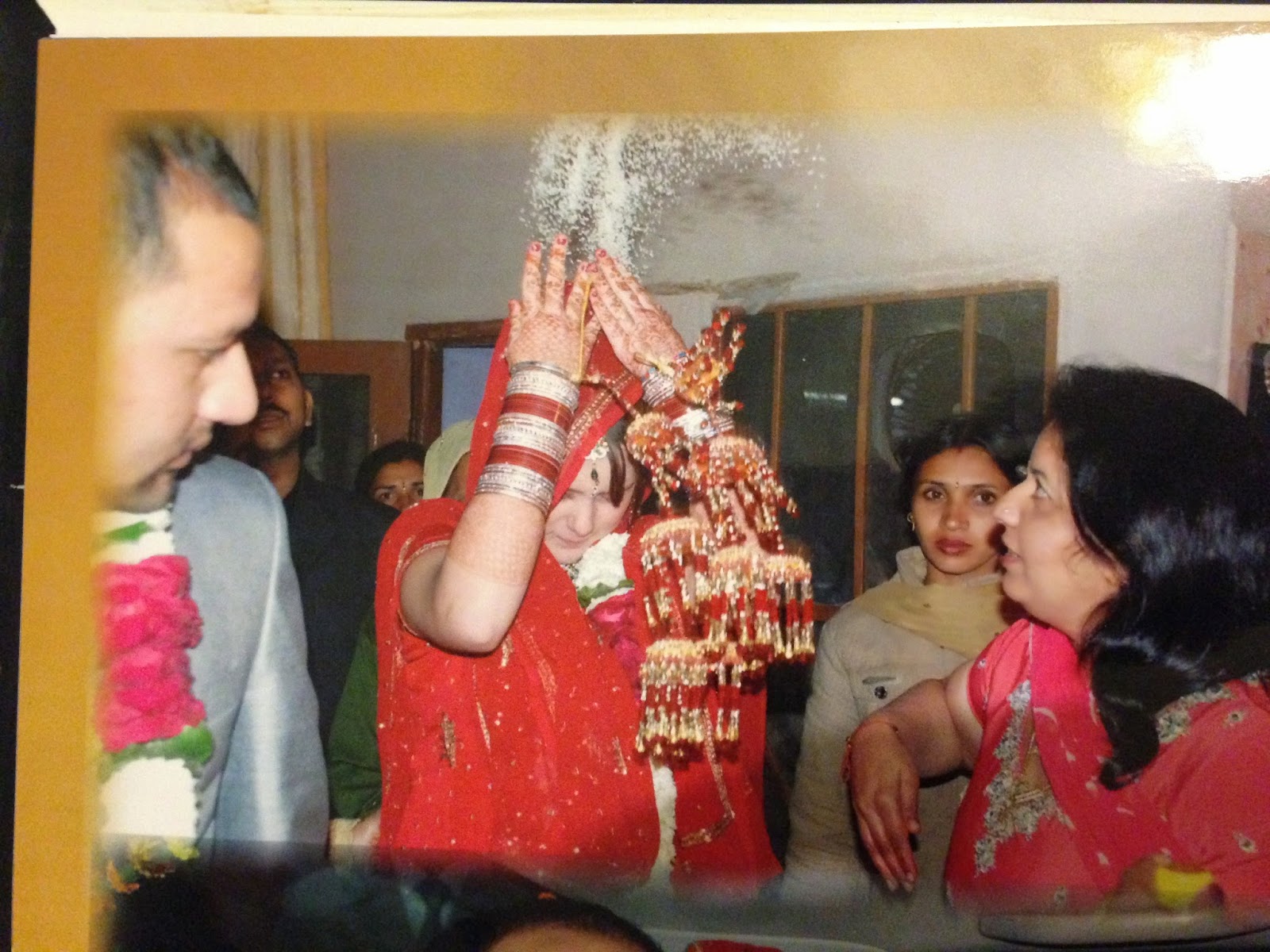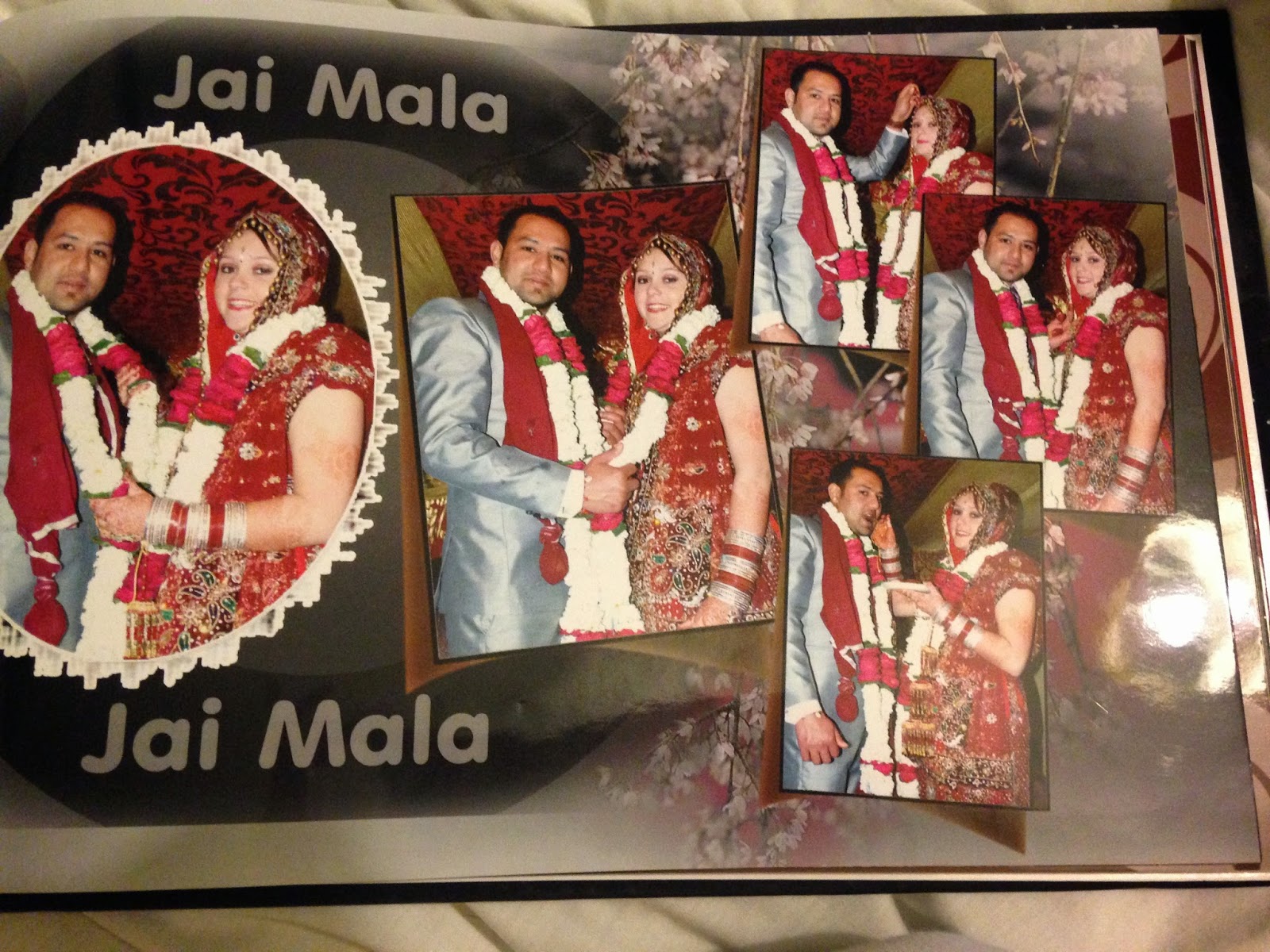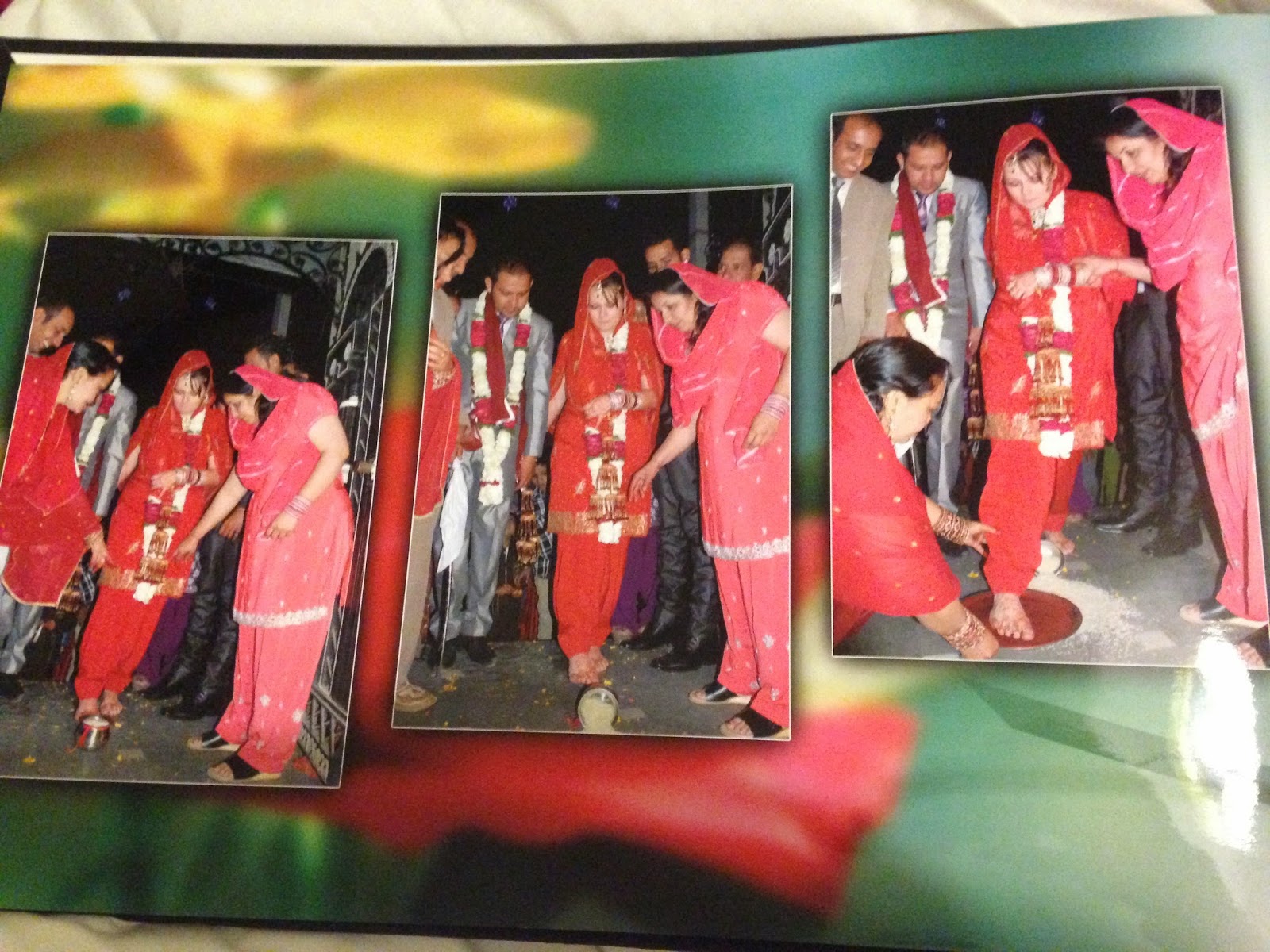Our wedding ceremony
Our marriage is a love marriage which is a marriage of two individuals based upon true love, the opposite to an arranged marriage.
Majority of the traditions I am about to explain to you are based on arranged marriages between two Indian’s as the house and families of the individuals play a huge part in Punjabi weddings. For my rituals we used Gautam neighbours as my family were not there, Nakita and Vicky both acted as my mum and dad and I also used their house as my house for the wife’s rituals. I will explain the traditional ritual and then I will how we made it our own as we were a love marriage. Gautam’s mum and dad are known to me as Mummy ji and Daddy ji, the ji is for respect. Gautam’s brother is my devar meaning brother in law.
Pre-wedding rituals
The first ritual to take place is the commitment between the girl and the boy that they will enter matrimony and won't consider any more matrimonial proposals. Praying is done which is then followed by the exchange of gifts.
Gautam and I promised our love to each other, we accepted the prayers and then Nakita and Vicky exchanged gifts between mummy ji and daddy ji.
 |
| Nakita and Vicky who acted as my parents. |
The fact that you are getting married is held a secret until this point, when people find out it is very high profile and especially with me being British it was a massive celebration for Gautam’s family and community. More gifts ( Punjabi style suits for the females, shirts and towels for the men.)
Rokka: Is another engagement ceremony but not the official one as during rokka the rings are not exchanged. Family and Friends this time come and give presents, money and their blessing to the couple to be. Everyone confirms that they are a match and the celebrate that their search has come to an end. The couple stand unofficially engaged, but people are aware that they are committed to their marriage.
During rokka Gautam and I confirmed for the final time that we were happy to get married and this time it’s done with the blessings of others. This part often encounters a lot of jealousy between family members, depending on how close the family are, I know that a lot of people in the community got jealous on Gautam’s family as I was British.
Sagai: is the official engagement, First the bride to be is draped with a chunni (headscarf) which is usually very elaborate. She is gifted with jewellery, which traditional her birth mother helps her wear. A small dot of mehndi which we know as henna is applied to her palm for good luck. The function is sealed with the exchange of rings. Everyone congratulates the couple by feeding them sweets.
 |
| Our official engagement party |
Our Sagai was lovely, all Gautam’s family member were there to give us their blessing, Nakita helped me apply my jewellery and chunni (head scarf). During our tradition the family gather round Gautam and I for a photograph they then presented us with money. Mummy ji, daddy ji and my devar Rohit fed us the sweets. Gautam and I exchanged rings, in India not all couples exchange rings and it’s not compulsory to wear them.
Sangeet: is eastern/western version of a bridal shower. The sangeet function is hosted by the girl’s family, in which only a few member from the boy’s family are invited. They play the dholki which is sort of like a drum and they sing songs.
My Sangeet was done at the same time as Gautam’s but the traditions took part in the neighbour's house. We had a massive party on the street at about 12.00pm the night before our wedding.
Mehndi/henna: this is the last major function before the wedding. The bridal party apply henna to the palms of the female family members hands. Only the bride has henna applied to both her hands and her feet. A basket of bindi' and bangles are handed around so that the woman can choose the ones that match their outfit that they plan to wear to the wedding. Apply the henna takes place in a party atmosphere. The bride's henna is sent by the mother in law, in which a beautiful design is chosen and decorated on the bride to be.
My henna was applied during the day outside the day before the wedding in the beautiful sunshine. At night females of Gautam’s family applied henna to each other.
Rituals at the brides home
Chuda: on the wedding day the rituals at the brides to be home begin to take place starting with the chuda ceremony. The girl does not see her chura until she is ready for her marriage. People touch the chura and give her their heartiest wishes for her future married life. also they sprinkle flower petals on the bride. After that the close family members of the girl tie’s kaliras to a bangle worn by the girl.
 |
| kalira's |
Mummy ji chose my chura which were beautiful! Traditionally you were your chura for the first year it’s been over a year since mine and Gautam's ceremony and I still am wearing mine, and will continue until Gautam is home as the chura represents my marriage to Gautam and Indian people know that I am a married woman.
I am on my second set of chura because during a visit to India security at a British airport made me remove my first set, I was very upset by this as you're not supposed to remove the as the encourage evil spirits. When I was in India Gautam and I were having a lots of bad things happen to us and I was constantly ill so I removed my first set and we chose a personalised set for me to wear, which I still wear to this day. Gautam's mum and I got ready together.
 |
| My first chura |
I am on my second set of chura because during a visit to India security at a British airport made me remove my first set, I was very upset by this as you're not supposed to remove the as the encourage evil spirits. When I was in India Gautam and I were having a lots of bad things happen to us and I was constantly ill so I removed my first set and we chose a personalised set for me to wear, which I still wear to this day. Gautam's mum and I got ready together.
 |
| My chura |
The Rut Jugga: in this ceremony, the family dances and sings the beautifully decorated home. Rut Jugga is celebrated in the late hours of the night. The family decorate copper or brass vessels called gagger, with clay laps which are filled with mustard oil and are lit up. The gagger is carried upon female family members heads when they're in company of the bride. They go around the neighbourhood with a band consisting of two men singing and playing a drum, also entering the homes of family and friends, they are welcomed by sweets and drinks, they dance outside and move on. This is a very loud ceremony carried out when dark.
My Rut Jugga was just short and sweet as I just carried the gagger around “my house”. Traditionally the bride and grooms are done separately and they aren't allowed to attend each others, Gautam didn’t attend mine but I attended Gautam's which started at about 11 pm. The Gagger is quite heavy and is carried upon your head, when you carry this it’s a symbol meaning you wish to get married. After we done out Rut Jugga we partied on the street as this was done on the same night of my Sangeet.
Rituals at the groom’s home:
Sehrabandi: The groom is dressed in his wedding attire. After the groom is dressed a prayer is performed. Thereafter, the groom’s sisters (sister of female cousins) ties the sehra in the grooms head. All those who witness this function must give gifts and cash to the groom as a token on good luck.
Gautam only has one female cousin and she tied the sehra to his head, Gautam’s father's oldest brother tied Gautam's turban. We did not see each other get dressed.
Varna: is a ceremony that wards off the evil eye/ black eyes. The groom’s bhabi (sister in law) applies black eyeliner to his eyes.
Black eyeliner is also applied to baby’s, it is applied to their eyes but often women will wear this behind their ears to ward off evil eyes, people who are believed to do black magic in India just out of spite/jealousy.
Rituals at the marriage venue
Milni: literally means introductions. The prayers are performed by the priest followed by formal introductions by the main male individuals. During the Milni ceremony the bride’s family give tokens of good luck to the grooms appropriate family members, beginning from the eldest. Cash and clothes are gifted also.
This part of our ceremony like most other was taken part in a temple close to Gautam's home.
laava: is one of the most important rituals of the wedding. It is the circling of the priest-Giani 4 times in a clockwise direction during set intervals.
- the first laava emphasizes the performance of the duty to the family and community.
- the second laava signifies the stage of yearning and love for each other.
- the third laava signifies the stage of detachment from the world.
- the fourth laava signifies the final stage of harmony and union in married life during which human love blends into the love for god.
in the first round the guru asked us to
- commit to righteousness- the state of moral perfection.
- renounce sinful actions.
- to mediate and embrace naam (sanskrit word for name).
- only by good fortune is real peace obtained.
- to workship the one waheguru and all our sins will vanish.
in the second round we were asked to further advance towards meeting the true guru being god. so he asks us to
- have fear of fearless god and your ego will disappear.
- sing god's praises and feel his presence before you.
- because god is everywhere, outside and within so we need to sing and enjoy.
in the third round, the guru says that the partners mind is filled with divine love.
- we should recite the gurbani and sing the glorious praises of lord, the naam will vibrate and resound within our hearts and we will know our future destiny.
in the fourth and final round, the guru says that the partners mind becomes peaceful and they have found the lord.
if we focus our consciousness on the lord, day and night, our desires will be fulfilled, our souls will blend with waheguru and only naam will occupy our hearts.
 |
| Listening to his prayers to get ready to walk around each time. |
After this part you are seen in India as husband and wife. after this we all left the temple and went for lunch and a part at a local hotel where many other traditions took place.
Jai mala/ varmala: The bride and groom come to the middle of the circle where the family is standing, they place a heavily made garland of flowers (varmala) they place it on each other, this ritual states that they accept each other and will love and live together with one another until death does them part. Friends and relatives of each party indulge in teasing and run, to celebrate this happy occasion.
This part of the ceremony was so much fun, this took part at our hotel venue. The teasing traditionally is being pulled away from the other partner while he/she tries to attach it around their neck. After this your applauded and then every individual/group family gather round the married couple and take photographs.
Kanyadaan: traditionally the bride’s father reapplies the grooms ring to his finger and “gives” his daughter to the groom. After this the groom applies Sindoor to her forehead.
Sindoor is the mark of a married woman, In which she wears in favour for her husband’s good health and future. When all these rituals are over the couple touch the feet of all the elder members in the family and seek their blessing for a happy married life.
Joota Chupai: literally means “hiding the shoes”. It is a fun tradition in which the bride’s sisters indulge in stealing the brides shoes, in which the girls charge a fee for agreeing to return the shoes.
In my case it was one of Gautam's male cousin, who stole my shoes and Gautam had to pay 1,000 rupees which is about £10. This price often varies depending on the individuals who stole it.
Post-wedding rituals
Vidaai/Doli: Vidaai marks the departure of the bride from her parental house. As a custom the bride throws puffed rice over her head. The ritual conveys her good wishes for her parents. This is a traditionally sad ritual, as here the bride says goodbye to her parents, siblings and rest of her family. Her male cousins traditionally lead her to her husband, who then will take her to his family home. Her relatives throw coins in the wake of this procession. In keeping with tradition the mother in law of the bride does not come to the Doli, as instead she makes preparations at her home to greet the arrival of her son and his new wife.
 |
| Vidaai |
 We done my departure at Gautam's neighbour's house, you take part in different rituals also one including retrieving a ring out of this bowl whoever gets the ring is considered to be in charge of the relationship. Mummy ji did not attend this part as she was in fact at home setting up, I had to shed a tear as this was my “goodbye” because in arranged marriages you usually move quite far from your parents house and it’s not very often you go back home and visit, this departure is culturally a bit thing.
We done my departure at Gautam's neighbour's house, you take part in different rituals also one including retrieving a ring out of this bowl whoever gets the ring is considered to be in charge of the relationship. Mummy ji did not attend this part as she was in fact at home setting up, I had to shed a tear as this was my “goodbye” because in arranged marriages you usually move quite far from your parents house and it’s not very often you go back home and visit, this departure is culturally a bit thing.Rituals observed at the groom’s house
pani warna: On arrival the mother in law has a glass of dirty water that is white in colour, in which she circles 3 times around her and offers her to drink it herself, as a symbol of her acceptance and blessing as her newest daughter.
During this I had to stop her from drinking this water as this water in unhygienic but the mother in law is always prepared to drink it.
















What a fantastic experience, I'm so glad you shared it! There's so much involved and it all sounds truly marvelous!! I'm sure these memories must help you to get though being so far apart and I hope you are able to be together forever soon! xxx
ReplyDeleteThank you so much sharon for your kind words. Im glad I had the opportunity to share it somewhere, it really was a great experience, it was extra special as its not what i expected my wedding to be like as you grow up thinking of that one special day, i felt like a proper princess as our ceremony lasted for a week, it was better than i could ever imagine. it was a proper celebration of true love. I didn't realise the meaning of all the traditions, i used to asked and be told that they didn't know why they done certain things its just a ritual. so researching it makes my day feel extra special. Gautam couldn't remember the meaning of the 7 circles around the priest, he used to say its hard to describe some things in english so reading about it really helps, and made me relive my special ceremony. these memories do help me get through the distance, thank you xx
DeleteI'm so glad you explained everything in detail! You are very lucky to understand everything so well. Many gori girls don't have that good fortune. hehe :)
ReplyDeleteThank you for taking your time to read it :) I done some reasearch as Gautam found it difficult to explain or he just didn't know why things were done that way :) x
DeleteI am really very happy after seeing ur story its really amazing,I am also in love with a gori rani ,she also loves me a lot ,i m eagrly waiting for our weeding and have the similar story .
ReplyDeletethank you
Delete-gori rani